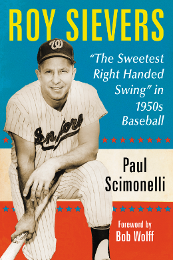Washington has had a host of steady third basemen over the years. In 2005 the Nationals drafted and quickly signed Ryan Zimmerman. In 2013 he will be entering his ninth year with the team. During that time he has hit 153 home runs and has a batting average of .287. In his eight seasons, Zimmerman has accumulated a 29 points under the WAR system, or roughly 4 a season, putting Zimmerman at the top of any third baseman to play for Washington. Injuries have hampered him over the years, hopefully healthy next season he should be entering his peak years. Oddly, despite the injuries, his 2012 Zip prediction of .283-22-78 was fairly close to his 2012 numbers of .282-25-95. If Ryan can stay healthy, he should benefit with a solid line-up giving him the opportunity to put up some impressive numbers. Based on his performance and expectations for the future he is clearly the top third baseman in District baseball history,
Right behind we place Cecil Travis. Travis played twelve years for Washington, the last three after he returned from World War 2. Sadly injuries suffered during World War II ended his effectiveness as a ball player. It should be noted that he received a Bronze Star and had part of his foot amputated. To be fair Travis played the majority of his games at shortstop, 710 of the 1,251 games he played in, and might have been better defensively at short. Cecil Travis had WAR rating of 28 in his time in Washington from 1933 to 1941. There are similarities between the players. Both arrived at an early age, 19 for Travis and 20 for Zimmerman. Both were solid offensive and defensive players, and well respected.
Behind Zimmerman and Travis is the surprising, to some, Ken McMullen. Ken played from here from 1965 until 1969. During his brief time in Washington, McMullen had a WAR rating of 19. McMullen came to the Senators from the Dodgers along with Frank Howard. Many fans might still remember the April 1970 trade when he was sent to the Angels. McMullen was well liked by the fans and was one of the better fielding third basemen of his time. Had some power too, sadly his skills quickly diminished after the age of 30.
In fourth place we would select Bill Joyce. Joyce played two and part of a third year for Washington. He held out his first year with Washington. Joyce played eight years, batting .293. He won the home run title in 1896 playing part of the year with Washington. The only knock on Joyce was his less than impressive fielding numbers. Putting Joyce on a roster would put a heavy hitter in the line-up with a high on base average. He would also put some ginger in the clubhouse. Some contemporaries consider Joyce to be the best Washington manager prior to 1901.
Eddie Yost, is perhaps better known for his nickname the “Walking Man.’ His WAR ratings are fairly low, a high of five when he was 26. Yost like some of the others came up early, reaching the majors at the age of 17 in 1944. Yost played for Washington until 1958. A .254 hitter, his lifetime OBP was .394, but he only lead the league in the category twice, and then when he was with Detroit. One of the league leaders in errors, range factor, putouts and assists at third base.
Ossie Bluege played in Washington from 1922 to 1939, a total of 1,867 games. His WAR rating is just around 2 a year. A highly regarded defensive player, said to be the first one to guard the line late in a game. He did hit .272 lifetime, but this in an era when .300 hitters were common. While most infielders typically go from shortstop to third, Ossie played shortstop and second base late in his career.
Harmon Killebrew had just two good years in Washington before heading off to Minnesota. He signed with Washington at 18 and under the rules of the day had to stay with the big league club for the first two years which might have hurt his development. In 1959 he came into his own hitting 42 home runs. But he also committed 30 errors. The next year he spent more time at first. He was signed by Ossie Bluege. Killebrew was a great player, just not at third.
Bill Coughlin played briefly on the 1899 Washington Club and then again with Washington from 1901 to 1904. Being one of the most valuable players on the franchise he was sold off to reduce the debt so Ban Johnson could sell the team. A hardnosed defensive specialist he was highly regarded by the fans. Coughlin batted in the 252 lifetime, a respectable number for his time.
Eddie Foster, “The Kid,” listed at just 5-06 and 145 pounds. As you can guess his power numbers are poor but he was one of the best in assists and range factor at his position. He spent a lot time in the minors, failing with the Highlanders, he was picked up by Washington and made his debut with them at the age of 26, playing eight years with them.
Buddy Lewis is next. He broke in as a teenager, his arrival moving Travis to shortstop. Despite some initial problems handling the hot corner he turned into a respectable defensive player. Lewis exhibited great range at third. Still Lewis would go through horrible defensive steaks at third. Rating by WAR based on age puts Lewis ahead of Zimmerman up to the age of 25. In 1940 at the age of 23 he was shifted to right field, where his athletic ability served him well. While Travis was shy, Lewis was a ladies’ man and very popular. Like Travis, Lewis lost three years to military service. Lewis was a transport pilot and made hundreds of dangerous flights over “the hump.”
For this comparison, Wins above Replacement, WAR, is used to compare players from different periods. The statistics from Baseball Reference.com, while there are numerous statistics available we wanted a generally used one that would allow for comparisons with players from different eras.






